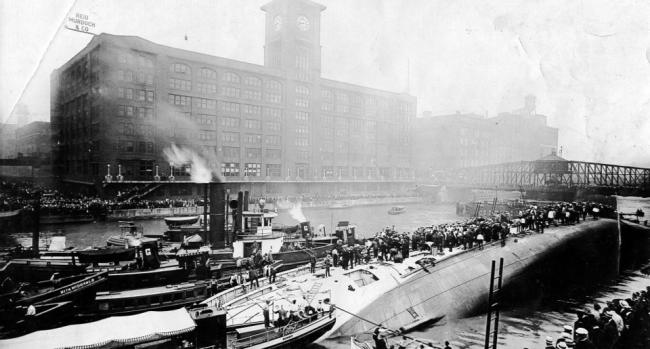Early on July 24, 1915 more than 2,500 people boarded the S.S. Eastland at the Clark Street Bridge over the Chicago River. The Eastland, known as the "Speed Queen of the Great Lakes," was the largest of five ships chartered to take Western Electric employees and family members on a company outing to Michigan City.
Even though it was a damp, chilly morning and many had gone below, many more passengers were on the top deck posing for photographs when the boat began to list. The crew drew in ballast water to try to right the ship but within minutes it rolled on its side and sank in 20 feet of water, trapping those who had gone below. 844 people lost their lives, including 22 entire families.[i]
The Oak Leaves reported that “…ten Oak Park and Forest Park people were carried to a tragic death. Many Oak Park people barely escaped with their lives...”[ii] Many of the victims were from Berwyn and Cicero, where the Western Electric plant was located.
Witness Jack Woodford, a writer for the Chicago Herald and Examiner, recalled the disaster in his autobiography. “As I watched in disoriented stupefaction a steamer large as an ocean liner slowly turned over on its side as though it were a whale going to take a nap. I didn't believe a huge steamer had done this before my eyes, lashed to a dock, in perfectly calm water, in excellent weather, with no explosion, no fire, nothing. I thought I had gone crazy.”[iii]
With the lead “a notable act of rescue,” the Oak Leaves reported that Frederick W. Willard of 506 N Elmwood pulled his father to safety through a port hole, “then tied a rope around his waist and plunged back into the water from which he had just escaped, and grasped many of the sinking and was pulled back with them to shore.” A man who assisted said that after saving 60 he fainted and was forced to give up. The article recounts several dramatic stories of survival of local residents.
Many of the dead were buried in nearby cemeteries. “All day long on Tuesday, Wednesday and Thursday, Madison Street, leading to Forest Home, Waldheim and Mt. Carmel cemeteries, was filled with one funeral procession after another. On Wednesday, the official mourning day, the procession of hearses did not stop at dusk, but continued until late in the evening.”
The Eastland, commissioned in 1902 had a checkered history. Design flaws made it unstable, and addition of more life boats and rafts, required by law after the Titanic sank, made it more top heavy. Crowding the upper deck apparently was enough to trigger the disaster. The media and public officials sought legal action but no one was ever brought to trial. Western Electric set up a relief fund and reserved vacant jobs for surviving relatives of the victims.
In an editorial the Oak Leaves put the disaster in context of the times. “The Eastland disaster is simply a colossal example of muddling and fumbling that results in daily loss of life …” It continues on the general evils of society, witnessed by the many people showing up at Western Electric on Monday to apply for jobs vacated due to the disaster. “The Eastland disasters, and their like, will never cease so long as we live in a society where every man feels that he has got to take advantage of his neighbors to save himself.”
That sentiment was echoed by Carl Sandburg in his poem, The Eastland, which closes with the lines
Yes, the Eastland was a dirty bloody job--bah!
I see a dozen Eastlands
Every morning on my way to work
And a dozen more going home at night.[iv]
The poem was considered too radical to be published at the time.
Submitted by John Elliott, June 2018
